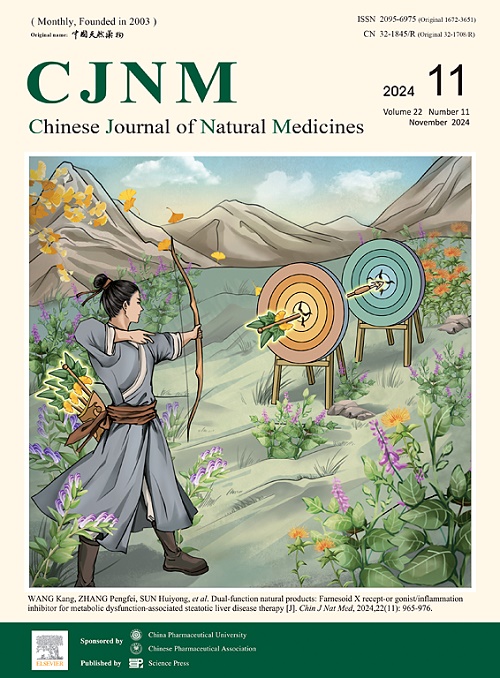Eudesmane-guaiane sesquiterpenoid dimers from Aucklandia costus trigger paraptosis-like cell death via ROS accumulation and MAPK hyperactivation
IF 4
2区 医学
Q1 INTEGRATIVE & COMPLEMENTARY MEDICINE
引用次数: 0
Abstract
Three novel sesquiterpenoid heterodimers, designated as auckcostusolides A–C (1–3), were isolated from Aucklandia costus leaves. The structures of compounds 1–3 were elucidated through comprehensive spectroscopic analysis, with their absolute configurations established using a combination of X-ray single-crystal diffraction and electronic circular dichroism (ECD) calculations. Notably, compounds 1 and 2, despite sharing identical planar structures derived from two identical sesquiterpenoids, exhibited opposite configurations at C-11 and C-8′. This configurational difference can be attributed to distinct Diels−Alder cycloaddition processes between the sesquiterpenoid monomers. Additionally, the cytotoxic effects of compounds 1–3 were evaluated against colorectal cancer HCT116 cells, fibrosarcoma HT1080 cells, and hepatocellular carcinoma HepG2 cells. Compounds 1–3 induced cell death was characterized by endoplasmic reticulum (ER) swelling and cytoplasmic vacuolization, typical morphological changes associated with paraptosis. Mechanistic studies revealed that compounds 1 and 3 triggered paraptosis-like cell death through the accumulation of reactive oxygen species (ROS), activation of ER stress, and stimulation of the MAPK signaling pathway.
木贼中的桉叶油倍半萜二聚体通过 ROS 积累和 MAPK 过度激活引发类猝死细胞死亡
从金莲花叶中分离出了三种新型倍半萜杂二聚体,命名为金莲花内酯 A-C (1-3)。通过综合光谱分析阐明了 1-3 号化合物的结构,并结合 X 射线单晶衍射和电子圆二色性(ECD)计算确定了它们的绝对构型。值得注意的是,尽管化合物 1 和 2 的平面结构完全相同,都来自两个相同的倍半萜,但它们在 C-11 和 C-8′ 的构型却截然相反。这种构型差异可归因于倍半萜单体之间不同的 Diels-Alder 环加成过程。此外,还评估了化合物 1-3 对结直肠癌 HCT116 细胞、纤维肉瘤 HT1080 细胞和肝癌 HepG2 细胞的细胞毒性作用。化合物 1-3 诱导细胞死亡的特征是内质网(ER)肿胀和细胞质空泡化,这些都是与凋亡相关的典型形态学变化。机理研究表明,化合物 1 和 3 通过积累活性氧(ROS)、激活 ER 应激和刺激 MAPK 信号通路引发了类猝灭细胞死亡。
本文章由计算机程序翻译,如有差异,请以英文原文为准。
求助全文
约1分钟内获得全文
求助全文
来源期刊

Chinese Journal of Natural Medicines
INTEGRATIVE & COMPLEMENTARY MEDICINE-PHARMACOLOGY & PHARMACY
CiteScore
7.50
自引率
4.30%
发文量
2235
期刊介绍:
The Chinese Journal of Natural Medicines (CJNM), founded and sponsored in May 2003 by China Pharmaceutical University and the Chinese Pharmaceutical Association, is devoted to communication among pharmaceutical and medical scientists interested in the advancement of Traditional Chinese Medicines (TCM). CJNM publishes articles relating to a broad spectrum of bioactive natural products, leading compounds and medicines derived from Traditional Chinese Medicines (TCM).
Topics covered by the journal are: Resources of Traditional Chinese Medicines; Interaction and complexity of prescription; Natural Products Chemistry (including structure modification, semi-and total synthesis, bio-transformation); Pharmacology of natural products and prescription (including pharmacokinetics and toxicology); Pharmaceutics and Analytical Methods of natural products.
 求助内容:
求助内容: 应助结果提醒方式:
应助结果提醒方式:


